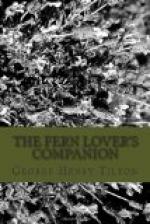[Illustration: Fig. 1]
[Illustration: Fig. 2]
[Illustration: Fig. 3]
The divisions of a pinnatifid leaf are called segments; of a bipinnatifid or tripinnatifid leaf, ultimate segments.
SPORANGIA AND FRUIT DOTS
Fern spores are formed in little sacs known as spore-cases or sporangia (Fig. 4). They are usually clustered in dots or lines on the back or margin of a frond, either on or at the end of a small vein, or in spike-like racemes on separate stalks. Sori (singular sorus, a heap), or fruit dots may be naked as in the polypody, but are usually covered with a thin, delicate membrane, known as the indusium (Greek, a dress, or mantle). The family or genus of a fern is often determined by the shape of its indusium; e.g., the indusium of the woodsias is star-shaped; of the Dicksonias, cup-shaped; of the aspleniums, linear; of the wood ferns, kidney-shaped, etc.
[Illustration: Fig. 4]
In many ferns the sporangia are surrounded in whole or in part by a vertical, elastic ring (annulus) reminding one of a small, brown worm closely coiled (Fig. 4). As the spores mature, the ring contracts and bursts with considerable force, scattering the spores. The spores of the different genera mature at different times from May to September. A good time to collect ferns is just before the fruiting season. (For times of fruiting see individual descriptions or chronological chart on page 220.)
HELPFUL HINTS
The following hints may be helpful to the young collector:
1. A good lens with needles for dissecting is very helpful in examining the sori, veins, glands, etc., as an accurate knowledge of any one of these items may aid in identifying a given specimen. Bausch and Lomb make a convenient two-bladed pocket glass for about two dollars.[1]
[Footnote 1: In the linen tester here figured (cost $1.50) the lens is mounted in a brass frame which holds it in position, enabling the dissector to use both hands. A tripod lens will also be found cheap and serviceable.]
[Illustration]
2. Do not exterminate or weaken a fern colony by taking more plants than it can spare. In small colonies of rare ferns take a few and leave the rest to grow. It is decidedly ill-bred to rob a locality of its precious plants. Pick your fern leaf down close to the root-stock, including a portion of that also, if it can be spared. Place your fronds between newspaper sheets and lay “dryers” over them (blotting paper or other absorbent paper). Cover with a board or slat frame, and lay on this a weight of several pounds, leaving it for twenty-four hours; if the specimens are not then cured, change the dryers. Mount the prepared specimens on white mounting sheets. The regulation size is 16-1/2 by 11-1/2 inches. The labels are usually 3-3/4 by 1-3/4 inches. A sample will suggest the proper inscription.




